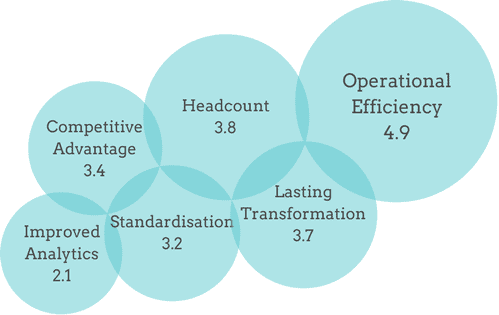Let’s talk about integrated systems, and how the best in the business automate call scheduling.
My work takes me to a lot of call centers, and I get to see many call handling processes up close. There is an amazing variety of approaches, a lot of creative technology deployments… and a lot of diverse problems to be solved.
But I’ve noticed that whenever the major problem is efficiency, the root cause is always the same – a complete lack of the right integration strategy.
If you know babelforce at all, you’ll know that sophisticated integrations are the name of the game for us. We choose to pour our energy into creating ever better integrations because experience has taught us – has taught me – that collaborative, unsiloed systems are the most important element of call center success.
What are the biggest anticipated gains from automations? (Scale 1-5)
1. Preparing Call Lists
There was a time when your contact center’s call list was a static paper ledger that agents worked through, one after another. Some of you remember it, hopefully you’re not still living it.
Now, your call list is more likely to be an onscreen list or table of items that agents work through, one after another. So in real terms, what has actually changed? Your business is using less paper? Even if businesses automatically generate calls with a dialer, it’s almost always based on uploading lists which are still essentially static.
The alternative is a process that draws data from a variety of integrated resources; think CRM, widgets on websites, chatbots, and more. These resources are all capable of supplying data to enrich your outbound call handling process by automatically updating when a customer makes an inbound call, or when a lead is captured through another channel, or when a process triggers a “call should be made” type of event. Two things to note: first, this setup is completely dynamic. Any event in any other process can immediately change an item, or how an entire list is handled. Second, this integrated approach avoids using human effort by applying intelligence in the automated processes.
Astoundingly, only a tiny minority of businesses claim to have this kind of call scheduling automation capability already in place, although over a quarter have their sights on it.
Integrating multiple data sources, and allowing that data to constantly update call lists, turns a static schedule into something dynamic and contextually aware.
[bctt tweet=”Without fully integrated systems, contact centers will never come close to their potential” username=”babelforce”]
2. Choosing and Equipping Agents
So let’s imagine you have your constantly evolving call list, updating and recycling as necessary. Now you need the capability to place those calls.
There is a lot of possible business logic that goes into assigning a particular call. At the broadest level, skill sets and training can dictate which agents are best suited. At the most granular level, individual case management might be required for some contacts. Here’s a research finding from Zendesk that’s keeping managers awake at night: 37% of customers expect to be able talk to the same agent consistently, even when switching channels.
Whatever the process driving agent selection, the highest performing contact centers have the ability to combine data on agent suitability – and availability – with data on call type.
But clearly, connecting the right agent to the customer is only half the battle. The agent also needs ready access to the customer’s data if they are going to have any chance of providing them with a service.
Rather than giving agents access to a database and leaving them to it, an efficient system delivers key customer data as part of the outbound dialling process. In research from Salesforce, 38% of agents voiced frustration at the difficulty in accessing the correct customer data.
I’m going to risk saying this again – the key to it all is the right integration.
 |
The average sales rep makes 52 calls per day… But it takes 18 attempts to reach the average prospect |
[bctt tweet=”#integration should mean freeing up human resources for the creative work that you can’t pre-program” username=”babelforce”]
3. Acting on Call Outcomes
So far it might sound like these integrations cover the entire call handling process. We’ve got scheduling and dialling behaviours based on real-time data, we’ve got agent selection linked to the same, and we have customer data delivered to agents right when they need it. So what’s missing…
In a way, integrating call outcomes is the most important part of the entire process. Was the call answered? Was a sale made or a query resolved, how long did it take, and are you meeting SLAs?
With the right integrations in place, call outcomes can service two key goals. First there’s performance tracking, which is an end in itself. I don’t know about you, but most contact center leaders I’ve spoken to want data on performance to be the force that guides strategy, rather than guesswork. When the British tax authority implemented these kinds of process automations into their customer framework, they saw a two minute drop in AHT – exactly the kind of progress you’ll want to track.
Secondly, there is the impact of outcomes on further call scheduling. Integration means automated processes that reschedule failed calls, that send SMS or email confirmations of purchases, or that simply let you know how many calls you should be making tomorrow.
And this whole process is cyclical – from the updated outcomes we arrive back at the start, updating the call lists.
Back to the start
I know from experience – you probably do too – that if any part of this integration is missing, the call throughput rate will be significantly slower than it needs to be.
That’s not even the main issue here. The main issue is that a lot of businesses are running suboptimal processes, simply because they’re not in a position to use data that they already have.
The data is there in BI, in CRM, in helpdesks, waiting to be put to use. And while it’s true that a lot of quality off-the-shelf products have some ability to ‘talk’ with other products, businesses are still hindered by the inflexibility of pre-built processes.
It’s for this reason that babelforce has put so much effort into creating a no-code automation platform that allows processes to change at the same speed as customer needs. By embracing a no-code system that non-technical staff can use, and combining it with deep data integrations, we’ve ensured that our clients have the power to automate call scheduling and create the call logic that they need.
Don’t waste your best resource planners on dreary manual processes that can be automated – integration should mean freeing up human resources for the creative work that you can’t pre-program.
And if that’s something you need – if you’re ready to let your integrated systems take over the grunt work – get in touch with babelforce today.






